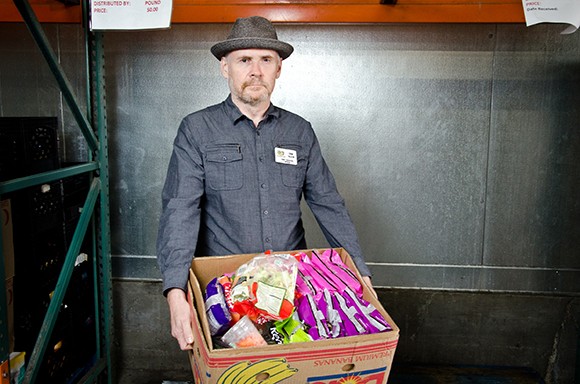Belt tightening: Amid drought, food banks face bare cupboards
IN THIS ARTICLE
- Agribusiness Topic
- Tony Biasotti Author
By Tony Biasotti Friday, March 7th, 2014

Erik Talkin, CEO of the Foodbank of Santa Barbara County. Its cooler shelves are down 75 percent of usual capacity of fresh produce as farmers donate less during the drought. (Alex Drysdale / Business Times photo)
Demand is up at the region’s food banks, and supply is down. In the for-profit world, those two factors would mean higher prices, but since food banks give away their products, their cupboards are starting to look a bit bare.
At the Foodbank of Santa Barbara County, the cooler shelves are down 75 percent of their usual capacity of fresh produce, the nonprofit said in mid-February. The main reason, the nonprofit said, is a significant drop in produce donated by farms in Santa Barbara County and throughout California.
“It’s definitely a shortage,” Foodbank CEO Erik Talkin said. “We rely on growers to donate their surplus, and there just isn’t as much surplus right now. There’s less being grown because of the drought, and what is being grown is more valuable than it was previously, so it’s going to market.”
The region’s three food banks help feed about 285,000 people in the Tri-Counties. Most of the food is distributed through smaller, local nonprofits that get their food from a county food bank.
In recent years, food banks have moved away from canned food and toward fresh produce, most of it donated by farms. That can put them at the mercy of cycles in the agricultural business, and the current cycle is one of lower volumes, higher prices and smaller surpluses. On top of that, more people are seeking help from food banks, due to cuts in federal food stamp funding.
Executives with the food banks in Ventura and San Luis Obispo counties say they’re feeling the squeeze, too, though not as severely as in Santa Barbara.
“We’ve been seeing a mild impact,” said Chris Aho, the community development officer with the Food Bank Coalition of San Luis Obispo County. “We’re still making all of our distributions and everything, but it is something that we’re keeping in the front of our minds strategically. There are going to be some pretty severe impacts from the drought, and we need to plan for that.”
In Ventura County, donations from farms to FoodShare were down about 20 percent in January from typical winter levels, said FoodShare CEO Bonnie Weigel.
“It’s not severe yet, but we are seeing a decrease,” she said. “We’re so grateful that there is surplus, and that our Ventura County ag community continues to give it to us. We’re always looking at it from their perspective, so if they don’t have that surplus, it means that market conditions are good and they’ve been able to sell it, and when that happens we’re happy for them.”
Drought to blame
Talkin said the farmers that regularly donate to the Foodbank of Santa Barbara County have told him the drought is largely to blame. Even though local growers have enough water, many farms in the Central Valley don’t.
That means coastal farms are filling the gaps in the market for many crops.
Surpluses are smaller for non-drought reasons, too. Limoneira CEO Harold Edwards said his company’s crops — primarily citrus and avocados — haven’t been affected by the drought. Citrus yields are down, though, due to a freeze early in the year, and avocado yields are about half of what they were last year, because avocado harvests typically work on a two-year up-and-down cycle.
Other crops are impacted by the lack of water, Edwards said. “The strawberry growers on the Oxnard plain are potentially facing extreme water shortage, and that could spill over to some of the row crops: the celery, lettuce, cabbage,” he said.
The Foodbank of Santa Barbara is dealing with its shortage in farm donations in a few ways, Talkin said: by buying more produce; using more dry, canned and frozen foods; and giving the organizations that distribute its food smaller allocations.
“We’re spending more money in the short term, and we’re trying to work with other food banks to identify what food sources we can still get,” Talkin said.
The Foodbank is also asking small farms and people with backyard gardens to donate their harvests, and it’s trying to expand its network of commercial growers who donate food. Both will be necessary if the Foodbank is going to keep its commitment to offering fresh, healthy food to the nearly one in four Santa Barbara County residents who need at least some help putting food on the table.
“This is not just cyclical,” Talkin said. “It is a more serious situation, and it just shows what a challenge water is in California.”
[CLARIFICATION: This article has been updated to reflect that the cooler shelves at Foodbank of Santa Barbara County are down 75 percent of their usual capacity of fresh produce.]











